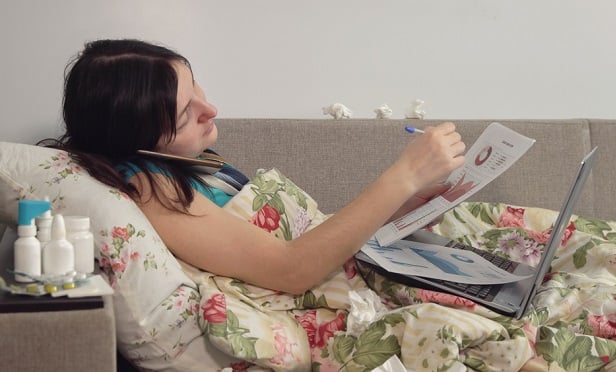 A boss may not want a coughing, sniffling employee in the office, but they may not believe that they deserve a day off from work entirely. (Photo: Shutterstock)
A boss may not want a coughing, sniffling employee in the office, but they may not believe that they deserve a day off from work entirely. (Photo: Shutterstock)
Has the internet helped or hurt employees' ability to strike a work/life balance? No doubt, it depends who you ask.
While technology has led an increasing number of employers to allow employees to work remotely or have flexible schedules, some workers find it impossible to disengage from the workplace when their phone is lighting up with emails from coworkers.
The shift towards remote work has also likely shifted attitudes towards sick days. A boss may not want a coughing, sniffling employee in the office, but they may not believe that they deserve a day off from work entirely. Even if they don't say it, the employees themselves may think it.
“Even if you take a sick day, you're still emailing in the morning, checking in later in the day,” Kit Warchol, head of content marketing for Skillcrush, an online coding school, tells the New York Times. “It's become more of a norm to write to your colleagues and tell them you're working from home.”
Of course, there are still plenty of jobs where on-site work is required. In those jobs, taking a sick day means not working at all. That includes food service workers, many of whom do not benefit from paid sick leave. They therefore have a strong incentive to work sick, putting coworkers and customers at risk of getting sick.
While employers have long strategized on how to reduce sick leave abuse, some employment experts believe that presenteeism is a much bigger problem. Presenteeism often refers to employees working despite an illness, but a broader definition includes employees who are at work but constrained by a lack of motivation.
In 2016, GCC Insights conducted a survey of 2,000 employees on their work habits. Based on their responses, GCC estimated that employees spent an average of 57 days a year on the clock doing something besides work.
One of the ways employers may seek to reduce burnout and therefore reduce presenteeism is by encouraging employees to take time off, both for vacation and for illness. Even if an employee is able to send emails and analyze spreadsheets, it may work out better in the long-run if they took the whole day to rest.
Complete your profile to continue reading and get FREE access to BenefitsPRO, part of your ALM digital membership.
Your access to unlimited BenefitsPRO content isn’t changing.
Once you are an ALM digital member, you’ll receive:
- Breaking benefits news and analysis, on-site and via our newsletters and custom alerts
- Educational webcasts, white papers, and ebooks from industry thought leaders
- Critical converage of the property casualty insurance and financial advisory markets on our other ALM sites, PropertyCasualty360 and ThinkAdvisor
Already have an account? Sign In Now
© 2024 ALM Global, LLC, All Rights Reserved. Request academic re-use from www.copyright.com. All other uses, submit a request to [email protected]. For more information visit Asset & Logo Licensing.








